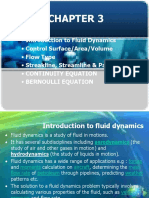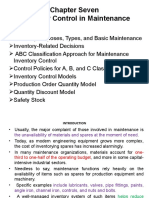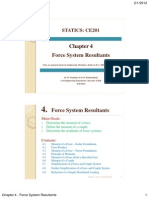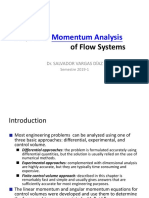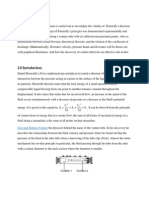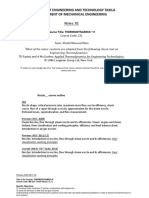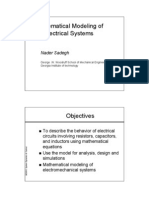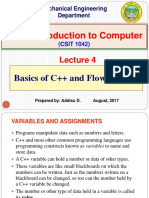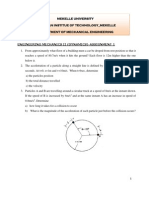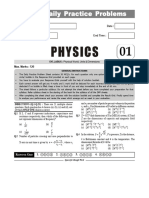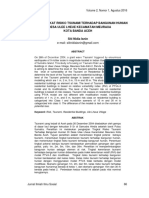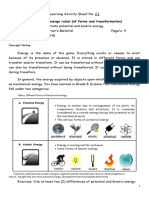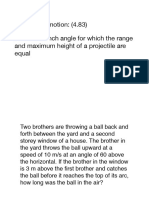Fluid Mechanics II (MEng 3306)
Fluid Mechanics II (MEng 3306)
Uploaded by
Addisu DagneCopyright:
Available Formats
Fluid Mechanics II (MEng 3306)
Fluid Mechanics II (MEng 3306)
Uploaded by
Addisu DagneCopyright
Available Formats
Share this document
Did you find this document useful?
Is this content inappropriate?
Copyright:
Available Formats
Fluid Mechanics II (MEng 3306)
Fluid Mechanics II (MEng 3306)
Uploaded by
Addisu DagneCopyright:
Available Formats
DEBRE MARKOS UNIVERSITY TECHNOLOGY COLLEGE MECHANICAL ENGINEERING DEPARTMENT
Course Number: MEng 3306 Course Title: Fluid Mechanics II Credit hours: 3
Course Objectives:
Program. Regular Academic year: 2012/2013 Class Year: III Semester: II
After completion of the course, the students will acquire the engineering-science knowledge of fluid mechanics needed to: Purse many mechanical engineering courses, especially those courses in thermal engineering stream Understand the principle of operation of lifting bodies like aircraft wings, blades of turbomachines, and the like Identify, formulate and solve engineering problems involving compressible fluid flows Understand the principles of operation of flow measuring instruments, conduct measurements, evaluate the data and draw conclusions Course Outline: 1. Two Dimensional Potential Flow Theory: 1.1. Introduction: circulation, vorticity, definition of potential flow 1.2. Basic equations for a 2-D potential flow 1.3. Velocity potential and stream functions of elementary potential-flow models: uniform flow, source/sink flow, vortex 1.4. Superposition of elementary potential-flow models: Rankine oval, Doublet; 1.5. Lifting flow over a cylinder and an airfoil, Kutta-Joukowski theorem; 1.6. Finite wing theory.
2. Compressible Flow: 2.1. Introduction, brief review of Thermodynamics; 2.2. The speed of sound, definition and classification of compressible flow; 2.3. Governing equations of isentropic flow with gentle area variation, stagnation properties; 2.4. Isothermal flow through pipes, Fanno and Rayleigh lines; 2.5. Normal shock wave: characteristic features, governing equations, calculation of properties; 2.6. Flow through convergent-divergent (De-Laval) nozzle; 2.7. Oblique shock wave: characteristic features, governing equations, calculation of properties; 2.8. Lift and drag on supersonic airfoils. 3. Mixed Jet Flow: Characteristic features; Semi-empirical models of the flow. 4. Flow Measurement: Density measurement; Viscosity measurement; Pressure measurement; Velocity measurement; Discharge measurement. Pre-requisite: MEng 2306 (Fluid Mechanics I) Teaching Methods: Lectures supported by tutorials and, Assignments, Attendance Requirement: Minimum of 75% attendance during lecture hours Evaluation: Assignments Mid-semester Examination Final Examination 10%, 30%, and 60%.
References: 1. Frank M. White, Fluid Mechanics 2. Streeters, Fluid Mechanics 3. Munson B.R, Fundamentals of Fluid Mechanics 4. Fox R.W., and McDonald A.T., Introduction to Fluid Mechanics
You might also like
- APM2613 - Lesson 1 - 0 - 2023Document9 pagesAPM2613 - Lesson 1 - 0 - 2023mmenzi101No ratings yet
- Transmission Lines: Steady-State OperationDocument30 pagesTransmission Lines: Steady-State OperationJihad HossainNo ratings yet
- Engineering Management Lecture NotesDocument19 pagesEngineering Management Lecture NotesSomefun Oluwasegun100% (2)
- 201 EMM Engineering ManagementDocument4 pages201 EMM Engineering ManagementBiKer___B0yNo ratings yet
- Undergraduate EconometricDocument29 pagesUndergraduate EconometricAcho JieNo ratings yet
- Engg Fluid Mechanics - SyllabusDocument2 pagesEngg Fluid Mechanics - SyllabusVivekVermaNo ratings yet
- Fluid Mechanics I (MEng 2306)Document2 pagesFluid Mechanics I (MEng 2306)addisudagneNo ratings yet
- Introduction To FluidmechanicsDocument28 pagesIntroduction To FluidmechanicsSomnath SwamyNo ratings yet
- 3a Fluid Dynamics - Continuity and Bernoulli EquationDocument66 pages3a Fluid Dynamics - Continuity and Bernoulli Equation翁绍棠No ratings yet
- 3.1 Conceptual Questions: Chapter 3 Kinematics in Two or Three Dimensions VectorsDocument18 pages3.1 Conceptual Questions: Chapter 3 Kinematics in Two or Three Dimensions VectorsnourNo ratings yet
- ReviewerDocument88 pagesReviewerGil Brian L. JaramilloNo ratings yet
- Photoelectric Effects in SemiconductorsDocument10 pagesPhotoelectric Effects in SemiconductorsSimion OngoriNo ratings yet
- Debre Markos University Technology College Mechanical Engineering DepartmentDocument4 pagesDebre Markos University Technology College Mechanical Engineering DepartmentAddisu DagneNo ratings yet
- Chapter 7Document37 pagesChapter 7kirubel AlemuNo ratings yet
- CE201 Statics Chap4 PDFDocument34 pagesCE201 Statics Chap4 PDFFazelah YakubNo ratings yet
- Experiment Archimedes' PrincipleDocument3 pagesExperiment Archimedes' Principlewan suhaizaNo ratings yet
- Chapter 6-MOmentum Analysis of Flow SystemsDocument49 pagesChapter 6-MOmentum Analysis of Flow SystemsSalvador Vargas-DiazNo ratings yet
- Chapter 1Document9 pagesChapter 1Bishal DasNo ratings yet
- Final ExamDocument3 pagesFinal ExamAddisu DagneNo ratings yet
- 3 Fluid-Mechanics PDFDocument114 pages3 Fluid-Mechanics PDFSantosh RaiNo ratings yet
- Central TendencyDocument26 pagesCentral Tendencyবিজয় সিকদারNo ratings yet
- Course Syllabus - Mechanics of MaterialsDocument6 pagesCourse Syllabus - Mechanics of MaterialsAlan Mauricio InsaustiNo ratings yet
- Engineering EconomicsDocument32 pagesEngineering EconomicsAkshayNo ratings yet
- The Second Law of Thermodynamics: Refrigerators EntropyDocument33 pagesThe Second Law of Thermodynamics: Refrigerators EntropyKristine Rodriguez-CarnicerNo ratings yet
- Phys114 Ps 1Document11 pagesPhys114 Ps 1Reine Amabel JarudaNo ratings yet
- Intro Engineering EconomyDocument10 pagesIntro Engineering EconomyMax DrakeNo ratings yet
- Fluid MechanicsDocument19 pagesFluid MechanicsPangerwati Ozukum100% (1)
- MS323 Engineering Management Course Outline OBE Spring 2021Document6 pagesMS323 Engineering Management Course Outline OBE Spring 2021AL RIZWANNo ratings yet
- Chap 8 LectureDocument27 pagesChap 8 LectureMuhammadAizatNo ratings yet
- Bernoulli's EquationDocument12 pagesBernoulli's Equationasfand12345100% (1)
- CE3301 FLUID MECHANICS SyllabusDocument1 pageCE3301 FLUID MECHANICS SyllabusBaskar Singh GNo ratings yet
- Engineering Economics Lecture 8 PDFDocument45 pagesEngineering Economics Lecture 8 PDFNavinPaudelNo ratings yet
- True FalseDocument6 pagesTrue FalsePhương Chu Thị BíchNo ratings yet
- Chapter Two: Kinematics and Dynamics of ParticlesDocument129 pagesChapter Two: Kinematics and Dynamics of ParticlesEphrem ChernetNo ratings yet
- University of Engineering and Technology Taxila Department of Mechanical EngineeringDocument53 pagesUniversity of Engineering and Technology Taxila Department of Mechanical EngineeringTechnical UETiansNo ratings yet
- STATICS Final Exam S2 2012-ADocument14 pagesSTATICS Final Exam S2 2012-AAbdullah NafiNo ratings yet
- Unequal Lives DruryDocument3 pagesUnequal Lives DruryZahid HussainNo ratings yet
- Lecture-4-Hydrostatic Force On Submerged BodiesDocument40 pagesLecture-4-Hydrostatic Force On Submerged BodiesSyed WasimNo ratings yet
- Estimating Demand: Regression AnalysisDocument29 pagesEstimating Demand: Regression Analysissamer abou saadNo ratings yet
- Physics Remedial ExamDocument1 pagePhysics Remedial ExamLeony Panjaitan100% (1)
- Heat 4e Chap05 LectureDocument49 pagesHeat 4e Chap05 LectureSubho Samanta0% (1)
- Chapter Five PDFDocument24 pagesChapter Five PDFعبدالله رعد حران 32No ratings yet
- Physics ProjectileDocument13 pagesPhysics ProjectileAnonymous r9DocC1WNo ratings yet
- Chapter One: Course ObjectivesDocument27 pagesChapter One: Course ObjectivesElias Weldeyohans100% (2)
- Phy 102 F2Document29 pagesPhy 102 F2Babalola AyokunuNo ratings yet
- OM Ch4Document47 pagesOM Ch4Mebre WelduNo ratings yet
- Units, Physical Quantities, and Vectors: BES 112 Module 1Document3 pagesUnits, Physical Quantities, and Vectors: BES 112 Module 1Waleed JaddiNo ratings yet
- Fluid MechanicsDocument97 pagesFluid MechanicsABDFERNo ratings yet
- Water Supply Engineering Ethiopia ProjectDocument1 pageWater Supply Engineering Ethiopia Projectkirubel zewdeNo ratings yet
- STAT CH2 Confidential IntervalDocument170 pagesSTAT CH2 Confidential IntervalMonny MOMNo ratings yet
- Lecture Notes2Document98 pagesLecture Notes2haggai ngosaNo ratings yet
- Energy and MomentumDocument20 pagesEnergy and MomentumAndrei Alido100% (1)
- Unit: 1: Newton's Laws of Motion & Principle of Transmissibility of ForceDocument5 pagesUnit: 1: Newton's Laws of Motion & Principle of Transmissibility of ForceKunal SinghNo ratings yet
- Mathematical Modeling of Electrical Systems: Nader SadeghDocument10 pagesMathematical Modeling of Electrical Systems: Nader SadeghAmr BalbolaNo ratings yet
- Hydrodynamics and Aerodynamics - MG - Lec3Document24 pagesHydrodynamics and Aerodynamics - MG - Lec3davididosa40100% (1)
- Fluid Mechanics: Dimensional Analysis and SimilitudeDocument70 pagesFluid Mechanics: Dimensional Analysis and SimilitudeVivek KasarNo ratings yet
- 3ME05 Fluid Mechanics: Course Learning ObjectivesDocument3 pages3ME05 Fluid Mechanics: Course Learning Objectivesgotu123No ratings yet
- Course Outline AASTU - 2021Document3 pagesCourse Outline AASTU - 2021Adnan ShafiNo ratings yet
- SYLLABUSDocument3 pagesSYLLABUSInzamam Ul HaqueNo ratings yet
- Lecture 1. Introduction To ComputersDocument102 pagesLecture 1. Introduction To ComputersAddisu DagneNo ratings yet
- Lecture 3. Introduction To Programming Using C++Document42 pagesLecture 3. Introduction To Programming Using C++Addisu DagneNo ratings yet
- Course OutlineDocument2 pagesCourse OutlineAddisu DagneNo ratings yet
- Unit 1. Introduction To Basci Technical DrawingDocument28 pagesUnit 1. Introduction To Basci Technical DrawingAddisu Dagne100% (2)
- Fluid Mechanics Ii (Meng 3306) : Worksheet 1 Chapter1. Potential Flow TheoryDocument4 pagesFluid Mechanics Ii (Meng 3306) : Worksheet 1 Chapter1. Potential Flow TheoryAddisu DagneNo ratings yet
- Engineering ThermodynamicsDocument30 pagesEngineering ThermodynamicsAddisu DagneNo ratings yet
- Final ExamDocument3 pagesFinal ExamAddisu DagneNo ratings yet
- Mekelle Weather DataDocument3 pagesMekelle Weather DataAddisu DagneNo ratings yet
- Past Thesis TitlesDocument9 pagesPast Thesis TitlesAddisu DagneNo ratings yet
- Dynamics Assignment 1Document7 pagesDynamics Assignment 1Addisu DagneNo ratings yet
- Fuel Cells: Technology DescriptionDocument5 pagesFuel Cells: Technology DescriptionAddisu DagneNo ratings yet
- 3.6.2 Radiation 00-10Document16 pages3.6.2 Radiation 00-10Murray PhysicsNo ratings yet
- CEC348 REMOTE SENSING I & II unitsDocument30 pagesCEC348 REMOTE SENSING I & II unitsjeron2934No ratings yet
- Fundamentals of Gas Dynamics (NOC16 - ME05) Assignment - 9: SolutionsDocument5 pagesFundamentals of Gas Dynamics (NOC16 - ME05) Assignment - 9: SolutionsIvan GoncharovNo ratings yet
- What Is Reflection of WaveDocument8 pagesWhat Is Reflection of WaveSyahida SyasyaNo ratings yet
- Heat Exchanger Performance AnalysisDocument7 pagesHeat Exchanger Performance AnalysisUsama IbrahimNo ratings yet
- Ieee Mapcon2023 CFPDocument1 pageIeee Mapcon2023 CFPRudra KumarNo ratings yet
- PROCOM r-70-7Document2 pagesPROCOM r-70-7Milic MilicevicNo ratings yet
- Fourier's Law: Module 2: Steady-State Heat ConductionDocument3 pagesFourier's Law: Module 2: Steady-State Heat ConductionJohnAdistubNo ratings yet
- CL X Scattering With Ques FinalDocument14 pagesCL X Scattering With Ques FinalarnavguptaNo ratings yet
- Edexcel Physics Definitions & Units (8PH01/9PH01) : AS Topic 3 WavesDocument2 pagesEdexcel Physics Definitions & Units (8PH01/9PH01) : AS Topic 3 WavesHeba M. UrabiNo ratings yet
- Diwali Physics Practice PaperDocument112 pagesDiwali Physics Practice Paperkamkishore2006No ratings yet
- Phy3 GravitationDocument3 pagesPhy3 GravitationsasikumarNo ratings yet
- AQA Motion Kinematics AnswersDocument20 pagesAQA Motion Kinematics AnswerskailistaceyNo ratings yet
- FR Goldschmied - Integrated Hull Design Boundary Layer ControlDocument10 pagesFR Goldschmied - Integrated Hull Design Boundary Layer ControlVictor PadillaNo ratings yet
- Heat Transfer Winds Test Review KeyDocument2 pagesHeat Transfer Winds Test Review Keyapi-110202130No ratings yet
- Assignment 5 Unit 5Document1 pageAssignment 5 Unit 5ayush.sangal.10.f.sdpsmznNo ratings yet
- Analisis Tingkat Risiko Tsunami Terhadap Bangunan Hunian Di Desa Ulee Lheue Kecamatan Meuraxa Kota Banda Aceh Siti Nidia IsninDocument19 pagesAnalisis Tingkat Risiko Tsunami Terhadap Bangunan Hunian Di Desa Ulee Lheue Kecamatan Meuraxa Kota Banda Aceh Siti Nidia IsninTimotius NugrohoNo ratings yet
- DRB - Lecture On Kinetics of Curvilinear TranslationDocument7 pagesDRB - Lecture On Kinetics of Curvilinear TranslationVianca CamilLe Incognito-Castillo PanganibanNo ratings yet
- 2019 Boltzmann EquationDocument31 pages2019 Boltzmann Equationlakshmipriya upNo ratings yet
- Section A-Multiple Choice (10 Marks) 1 A B C D 2: Pearson Science New South Wales 9 Chapter 4 TestDocument9 pagesSection A-Multiple Choice (10 Marks) 1 A B C D 2: Pearson Science New South Wales 9 Chapter 4 TestAbigail ScottNo ratings yet
- Annex 0 - Delivery Format - Pre TaskDocument5 pagesAnnex 0 - Delivery Format - Pre TaskMemilio DE Las TorresNo ratings yet
- Practice Test 04 _ Hints & Solutions __ Yakeen Plus 2025Document15 pagesPractice Test 04 _ Hints & Solutions __ Yakeen Plus 2025hundekarshubham18No ratings yet
- G9 Unit 4 Module 2c0nsolidatedDocument21 pagesG9 Unit 4 Module 2c0nsolidatedmalucilane.acabalNo ratings yet
- Homework 1Document11 pagesHomework 1salvadorsilveyra@hotmail.com0% (1)
- ProblemsDocument16 pagesProblemsarvapallNo ratings yet
- This Year's Exam Average Score: PH1012 Physics A AY2022/23 Sem 1 Examiners' ReportDocument6 pagesThis Year's Exam Average Score: PH1012 Physics A AY2022/23 Sem 1 Examiners' Reporth3425034No ratings yet
- Acoustics EdgeDocument171 pagesAcoustics EdgeKristopher Archie Plaquia50% (2)
- Modern Physics and Nuclear Physics (PP) 2019 (Unsolved)Document4 pagesModern Physics and Nuclear Physics (PP) 2019 (Unsolved)bilalazam31No ratings yet
- CME 341 Heat Transfer: Dr. Hameed MuhamadDocument28 pagesCME 341 Heat Transfer: Dr. Hameed MuhamadŔorětāRěɱixNo ratings yet
- Local Media7333700941838035745Document24 pagesLocal Media7333700941838035745Wyne AceroNo ratings yet








